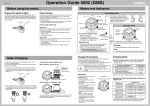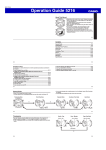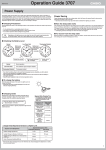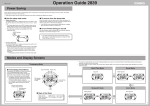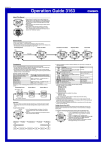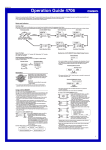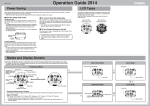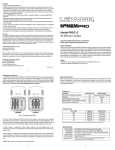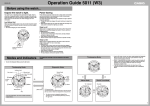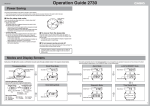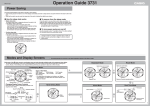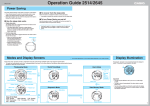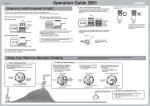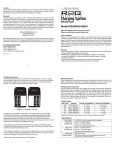Download Casio MA0811-EA User's Manual
Transcript
Operation Guide 4323 (GMS) MA0811-EA Before using the watch... Power Supply (Charging) Your watch runs on electrical power generated from light, which is stored by a chargeable battery. To ensure stable operation, make sure that the watch is exposed to light as much as possible. Expose the watch to light. Your watch runs on electrical power generated from light, which is stored by a chargeable battery. Longterm storage of the watch can cause power to run low, so be sure to expose the watch to light for some time before using it for the first time. For information about charging time, see “Power Supply.” • Whenever you are not wearing the watch on your wrist, position it so the face (solar cell) is pointed in the direction of a source of bright light. 3OLARCELL • When wearing the watch, try to keep your sleeve from blocking its face, where the solar cell is located. ,IGHT Power Saving Power Saving causes the watch to enter a sleep state automatically and stop movement of the analog hands in order to save power whenever the watch is left in the dark. The watch will exit the sleep state if you expose it to light or perform any button operation. • Note that the watch also may enter the sleep state and stop if its face is blocked from light by your sleeve. How the sleep state works Sleep Level 1 Sleep Level 1 is triggered whenever the watch is left in the dark for about one hour any time between the hours of 10 p.m. and 6 a.m. • The second hand will stop at 12 o’clock. • The hour and minute hands continue to operate normally. Sleep Level 2 Sleep Level 2 is triggered whenever the watch is left in the dark while in Sleep Level 1 for six or seven days. • Hour, minute, and second hands stopped at 12 o’clock • Auto Receive disabled • Timekeeping continues internally. Leave the watch under fluorescent lighting, near a window, etc. Charging efficiency is reduced significantly even if the face of the watch is covered only partially by your sleeve. How the solar cell and battery work While the watch is exposed to light... ,IGHT While the watch is not exposed to light... 3OLARCELL ,IGHTCHARGES THEBATTERY %LECTRICALENERGY $ISCHARGE #HARGE General Guide Your watch continues to operate even when it is not exposed to light. Leaving the watch in the dark can run down its battery and cause functions to become disabled. -ANUAL2ECEIVE (OURHAND !BOUTSECONDS -INUTEHAND 2ECHARGEABLE BATTERY 0OWERSUPPLIEDTOWATCH 2ECHARGEABLE BATTERY 0OWERSUPPLIEDTOWATCH Charging Precautions OR 4OCHECKTHERESULTOFTHE LASTRECEIVEOPERATION 7HILERECEPTION ISINPROGRESS !TTHESTARTOFTHE RECEIVEOPERATION Avoid charging the watch in the following locations, and anywhere else where the watch may become very hot. • On the dashboard of an automobile parked in the sun • Very close to an incandescent light source or other sources of heat • In a location exposed to direct sunlight for long periods Depending on the light source you are using, the case of the watch may become quite hot when charging. Take care to guard against burn injury after charging. 3ECONDHAND Dead Battery 3UCCESSFUL 5NSUCCESSFUL A button • Press to view the last receive result. • Hold down for about two seconds to trigger time calibration signal manually. B button • This button is used when correcting hand home positions and when setting the time. ■ To check the result of the last signal receive operation During normal timekeeping, press the A button. • This will enter the last signal receive mode. The second hand to move to “Y” (or “YES”) if the last receive operation was successful or to “N” (or “No”) if the last receive operation was unsuccessful. • Press the A button to exit the last signal receive mode. • The watch will exit the last signal receive mode automatically if you do not perform any button operation for one or two minutes. The following conditions apply when the battery is dead. • Timekeeping stops. • Auto receive and manual receive are disabled. • Second hand stops immediately at 12 o’clock. • Hour and minute hands stop at 12 o’clock at noon. • Even if the battery level drops to the point that timekeeping stops, you still will be able to recharge the battery and use the watch again. • After you recharge the battery after it drops to a level where timekeeping stops, the hands will move automatically to the current time setting. • Try to keep the watch exposed to light as much as possible during normal use. $EAD"ATTERY (ANDSSTOPATOCLOCK Charging Guide Required Charging Time for One Day of Operation The values in this section are base on six minutes of signal reception and 10 seconds of alarm operation per day. Exposure Level (Brightness) Charging Time Outdoor Sunlight (50,000 lux) 9 minutes Sunlight through a Window (10,000 lux) 32 minutes Daylight through a Window on an Overcast Day (5,000 lux) 51 minutes Indoor Fluorescent Lighting (500 lux) 8 hours Making sure the watch is exposed to light ensures stable operation. Approximate Charge Times Required to Advance to a Higher Level Exposure Level (Brightness) Charging Time Until Hand Until Full Charge Movement Restarts Outdoor Sunlight (50,000 lux) 3 hours Sunlight through a Window (10,000 lux) 9 hours 68 hours Daylight through a Window on an Overcast Day (5,000 lux) 14 hours 110 hours Indoor Fluorescent Lighting (500 lux) 146 hours −−− 19 hours • Note that the above charging times are for reference only. Actual charging time depends on a variety of environmental factors. 1 Operation Guide 4323 (GMS) How a Radio-controlled Watch Works What is a radio-controlled watch? A radio-controlled watch is designed to receive a time calibration signal that contains standard time data and adjust its current time setting accordingly. 4RANSMITTER Signal Reception ,ONGWAVETIME CALIBRATIONSIGNAL There are two methods you can use in order to receive the time calibration signal. 7ATCH #ESIUM ATOMICCLOCK Auto receive Up to six times a day (Midnight, 1:00, 2:00, 3:00, 4:00, 5:00 a.m.) Manual receive (You initiate signal reception by pressing a button.) Calibration Signal The Japanese calibration signal (Call Sign: JJY) is maintained by the National Institute of Information and Communications Technology (NICT). It is transmitted 24 hours a day from the Mt. Otakadoya transmitter (40 kHz) located in Tamura-gun, Fukushima Prefecture, and from the Mt. Hagane transmitter (60 kHz) located on the border between Saga Prefecture and Fukuoka Prefecture. During normal timekeeping, hold down A for about two seconds until the second hand moves to “READY”. At the start of the receive operation • The second hand moves to “READY”. • The hour and minute hands continue to operate normally. The time data of the Japanese calibration signal (Call Sign: JJY) is maintained by the Japan Standard Time Group of the National Institute of Information and Communications Technology (NICT). Note that transmission of the calibration signal may be interrupted occasionally due to maintenance, lightning, etc. For more information, visit the website of the Japan Standard Time Group of the National Institute of Information and Communications Technology (NICT) at the following URL. While reception is in progress • The second hand moves to “WORK”. • The hour and minute hands continue to operate normally. • Do not perform any watch operations while signal reception is in progress (second hand at “WORK”). 2%!$9 http://jjy.nict.go.jp When reception is complete... • When the receive operation is successful, the second hand will move to “Y” or “YES”, the watch will adjust its time, and then the second hand will return to normal operation after about three minutes. • If the receive operation is not successful, the second hand will move to “N” or “NO”. The second hand will return to normal operation after about three minutes. ■ To cancel a manual receive operation • Note that the above URL is subject to change. Reception Ranges KM 7/2+ Press any button. 9OR9%3 SUCCESSFUL .OR./ UNSUCCESSFUL ■ To position the watch for optimum reception Remove the watch from your wrist and place it somewhere so its top (12 o’clock side, where the antenna is located) is pointing approximately in the direction of the signal transmitter. Keep the watch away from metal objects. -T/TAKADOYAK(Z KM KM -T(AGANEK(Z KM • Orienting the watch so it is sideways to the transmitter makes it more difficult for it to receive the signal. • Do not move the watch while it is receiving the calibration signal. 2ESINBAND Under optimum conditions, the calibration signal should be receivable up to 1,000 kilometers from the transmitter. Note that the wave is relatively weak at distances greater than 500km, so reception may be poor at long distances. • Geographic contours, nearby buildings, the season, the time of day, can make reception impossible even when you are within range of the transmitter. • Best reception is possible late at night. Location -ETALBAND Reception is difficult and may even be impossible in the locations described below. Avoid such locations when performing signal reception. • You should think of your watch as operating like a radio or TV when it is receiving the calibration signal. Time Required for Reception Signal reception normally takes anywhere from about two to seven minutes. Under certain signal conditions however, the receive operation can take as long at 14 minutes. Troubleshooting Among or near buildings Near high-voltage lines Next to a household appliance or office equipment (TV, speaker, fax, computer, cell phone, etc.) Inside an automobile, train, plane, or other vehicle At a construction site, airport, or other location where there is radio interference Near mountains 1. The watch cannot receive the time calibration signal. • Is the signal being transmitted? Though the time data of the Japanese calibration signal (Call Sign: JJY) is maintained by the Japan Standard Time Group of the National Institute of Information and Communications Technology (NICT), it sometimes may be interrupted for periodic maintenance work, or because of lightning or other problems. • Are you within the reception range of a transmitter? • Is there something in the immediate area that may be interfering with reception? Even if you are within the reception range of a transmitter, electrical noise or objects between you and the transmitter can interfere with reception. Avoid such areas during signal reception. 2. Time calibration signal reception is successful, but the hourly time signal and current time are slightly off. • After the watch receives the time calibration signal, it performs an internal decoding process before updating its time setting. Because of this, the time setting may be off slightly (within one second). 3. Time calibration signal reception is successful, but the current time setting is wrong. • Are the home positions of the hands off? Refer to “Home Position Adjustment” and check the hand home positions. If you are experiencing problems with reception, move away from the types of locations described above to a location with better reception, and try again. Calibration Signal Reception Precautions • Pressing any button while auto receive is in progress will cause the watch to exit the receive operation. • Make sure you are within the range of a calibration signal transmitter before performing the receive operation. Remember that geographic contours, nearby buildings, the season, or the time of day can make reception impossible even when you are within range of the transmitter. • Proper reception may be impossible if there is something blocking the signal. If reception is unsuccessful, try again. • This watch is designed to adjust its current time setting in accordance with the calibration signal transmitted in Japan only. Note that you will need to make your own adjustments when using this watch outside of Japan, or in any area that is outside the range of one of the receivable time calibration signal transmitters. • When the watch is unable to adjust its time using the calibration signal for some reason, timekeeping accuracy is within ±20 seconds per month. • Strong electrostatic charge can cause timekeeping error. 2 Operation Guide 4323 (GMS) Adjusting the Time Manually You can perform the following procedures to adjust the time and date when the watch is unable to receive a time calibration signal for some reason. ■ To enter the adjustment mode During normal timekeeping, hold down the A button for about five seconds until the second hand moves to “READY” and then to either AM or PM, depending on the current time setting. .ORMAL4IMEKEEPING Home Position Adjustment If the time setting of your watch is not correct even though time calibration signal reception is being performed normally, use the procedure in this section to check the home positions of the hands and make adjustments as required. Note that you do not need to perform the following operation if your watch is showing the correct time. ■ To enter the home position adjustment mode • During normal timekeeping, hold down the B button and then the A button, keeping both buttons depressed for about five seconds until the second hand stops in the vicinity of 12 o’clock. (OURAND-INUTE(AND!DJUSTMENT !0- .ORMAL4IMEKEEPING 3ECOND(AND!DJUSTMENT !BOUTSECONDS BUTTON -OVESHOURAND MINUTEHANDS #LOCKWISE AND !BOUTSECONDS (OME0OSITIONOCLOCK s 4HESECONDHANDISIN THECORRECTPOSITIONIFITIS POINTEDATOCLOCK)FIT ISNTUSETHEBUTTONTO ADJUSTIT BUTTON -OVESTHESECONDHAND #LOCKWISE !-0-3WITCHING s 3ECONDSRESTARTFROM AFTERTHETIMEISADJUSTED 0- BUTTON !-0-SWITCHING • Holding the B button will cause the second hand to start to move at high speed. To stop high-speed hand movement, press the B button again. High speed hand movement also will stop automatically if the hour hand completes one revolution (12 hours). • The watch will exit the adjustment mode automatically if you do not perform any operation for about two or three minutes. (OURAND-INUTE(AND!DJUSTMENT (OME0OSITIONOCLOCK s 4HEHOURANDMINUTE HANDSAREINTHECORRECT POSITIONSIFTHEYARE POINTEDATOCLOCK)F THEYARENTUSETHE BUTTONTOADJUSTTHEM BUTTON -OVESHOURAND MINUTEHANDS #LOCKWISE • Holding the B button during second, hour, and minute hand adjustment will cause the second hand to start to move at high speed. High-speed movement will continue even if you release the B button. To stop high-speed hand movement, press the B button again. High-speed second hand movement will stop automatically after the hand completes a 60-second revolution. High-speed hour and minute hand movement will stop automatically after the hands complete a 12-hour cycle. • The watch will exit the home position adjustment mode automatically if you do not perform any operation for about two or three minutes. 3



